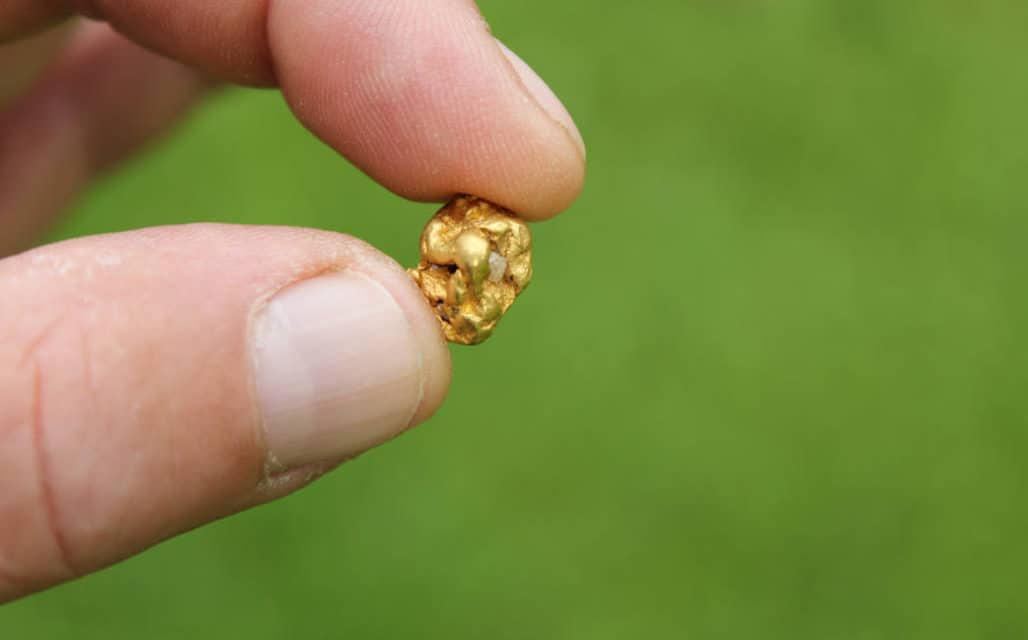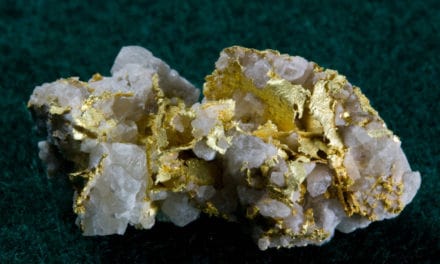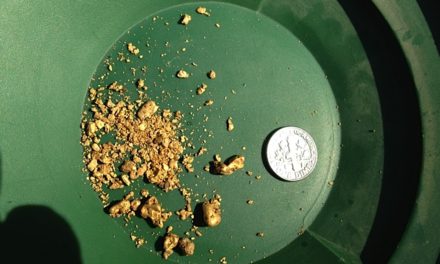The dog barked and splashed in the water next to the 49er as he was cleaning out his sluicebox. He could see some choice nuggets in the riffles and as he reached in to pick up a good-sized chunk, his dog bumped his arm sending it back into the stream. The miner was about to curse his best friend when he spotted something glistening under the water next to his fallen gold nugget.
His eyes were not the best at his ripe old age of 38 but there was no mistaking this observation. He carefully reached into the water, first picking up his fallen nugget, then grabbing onto the bigger piece and brought it out of the water to look at it. Within a milky white chunk of rounded quartz was a half-inch vein of gold. The miner shouted “Eureka!” He grabbed his dog and gave him a big hug, telling him “good boy, you have a nose for the gold!”
The dog and the miner played in the water for the next hour, splashing each other, throwing sticks, and laughing and barking up a storm, then the miner went back to work. The dog curled up on the bank of the stream in the warm California sun and watched the man work. It was another good mining day and visions of a heaping dog bowl filled his mind as he drifted off to doggie dreamland.
The 49ers were often lucky and chance would play a large role in finding rich pockets of gold along the stream banks in the California Mother Lode. Perhaps there was just so much gold that it wasn’t luck at all, maybe all they just had to do was perform the hard work necessary to find it. More likely it was a combination of both luck and hard work.
Good miners have 20-20 gold vision. They call it “reading the river”. Being able to use their mind’s eye to see where the old river channel was under all the flood gravel or vegetation. Gold is 19.3 times heavier than water so the larger nuggets and the majority of the gold (called the “paystreak”) will be within inside bends of the stream, behind natural rock ledges or underneath large boulders. It is the boundary between swift and slow water. These features often become buried over time or the river moves to another part of the valley, hiding where the past river channels really were. Being able to read the river is critical to optimizing the prospector’s limited resources to get the most gold.
Reading the river is very important in the upland creeks and streams too. Here, gold tends to concentrate a bit differently. Bedrock is more common and flood scouring plays a more important role. Imagining how the gold particle, flake, picker, nugget or even the slammer would react and then deposit given those conditions is paramount. Imaging what the bedrock looks like under several feet of gravel is a prospector’s gift. Once you have 20/20 gold vision, you too will be in the pay and on the gold. There is still a lot of gold left in them thar hills!
There is a modern day gold rush going on right now and you can be apart of it too. Go out and give it a try. Get yourself a mining claim, talk to a geologist, buy some simple prospecting tools and join the rush. It is something within our blood – something that we feel is right. Today’s miners are smarter than every before. They have better tools to recover the precious metal and the wisdom to work with Mother Nature. Today’s miners are responsible citizens and reclamation is part of their mining process.
It is a thrill to find your first gold speck, flake or nugget. Once you do, you will be hooked forever. It is fun for the whole family and who knows, maybe, just maybe, if you are a wee bit lucky… you too will jump for joy, click your heels, and shout “Eureka! I found it!”
Charles P. Watson is the chief geologist at Advanced Geologic Exploration, Inc. located in Chester, California. He can be reached at cwatson@advancedgeologic.com or at www.advancedgeologic.com
Advanced Geologic is a purveyor of high quality gold mining claims. They also provide superior mining and geologic advice and can assist you with your all permitting needs. The gold rush is on! Contact them and claim your fortune!












